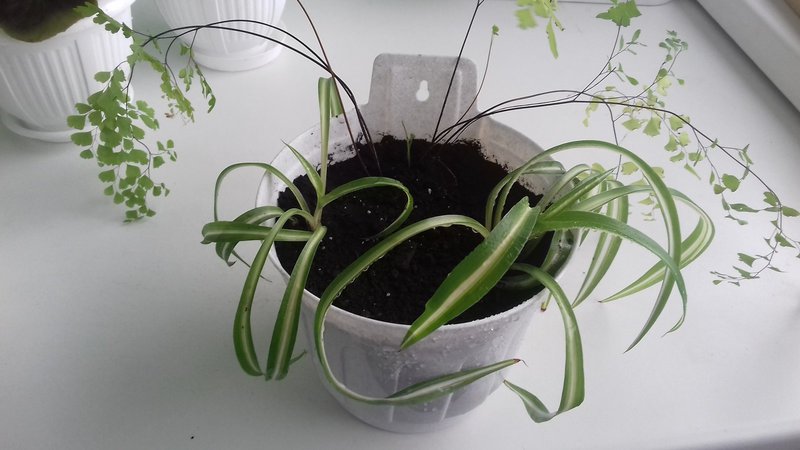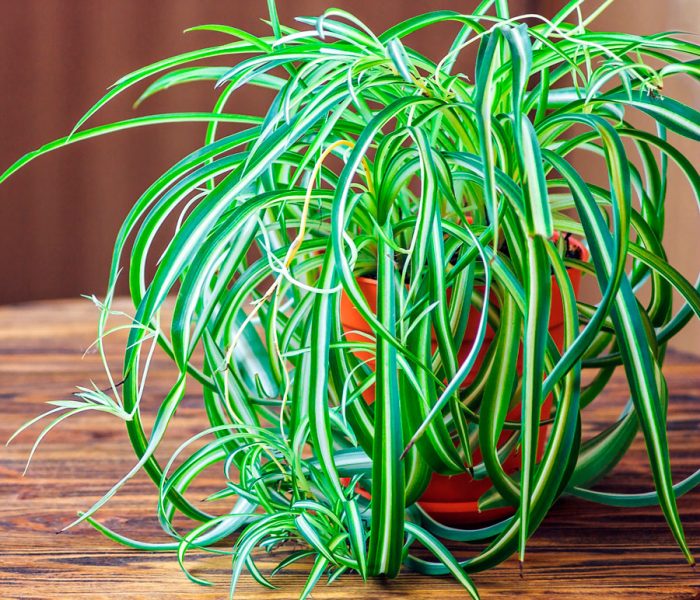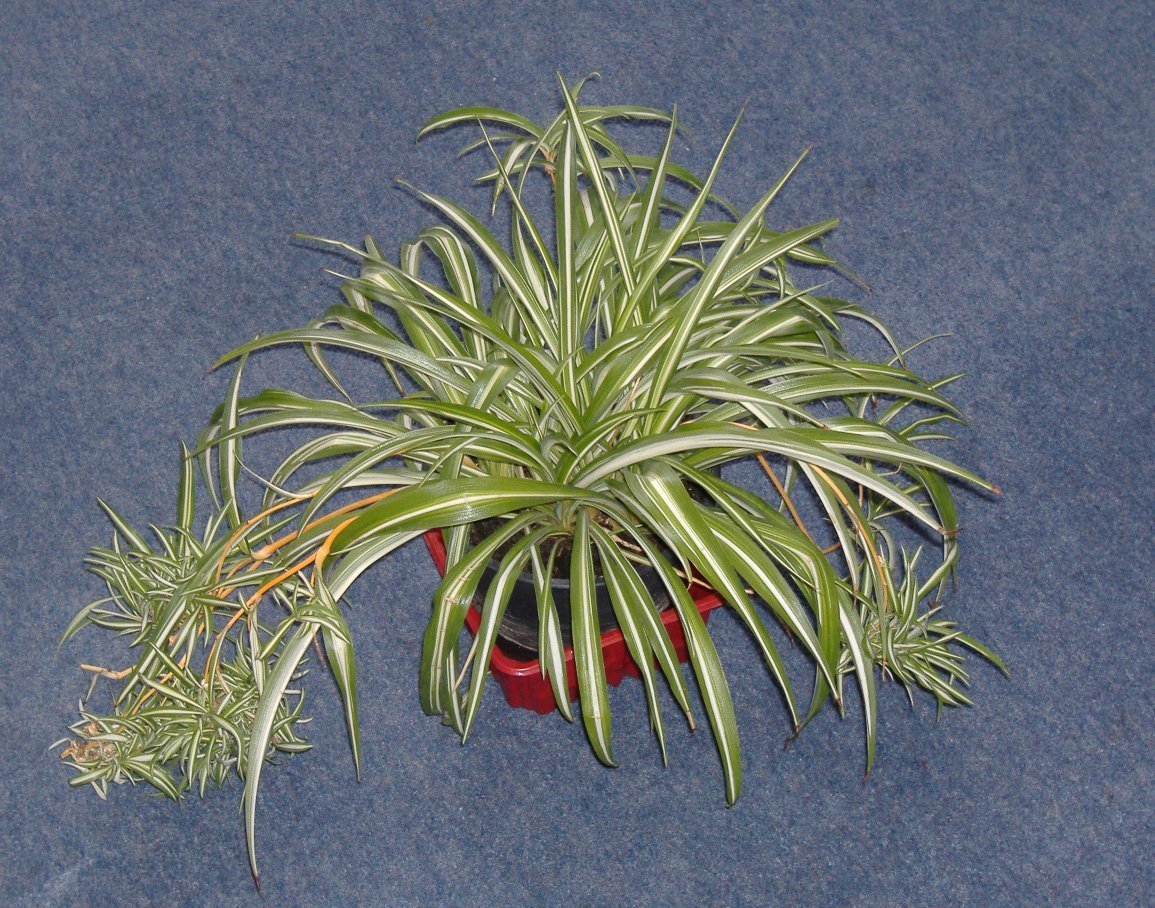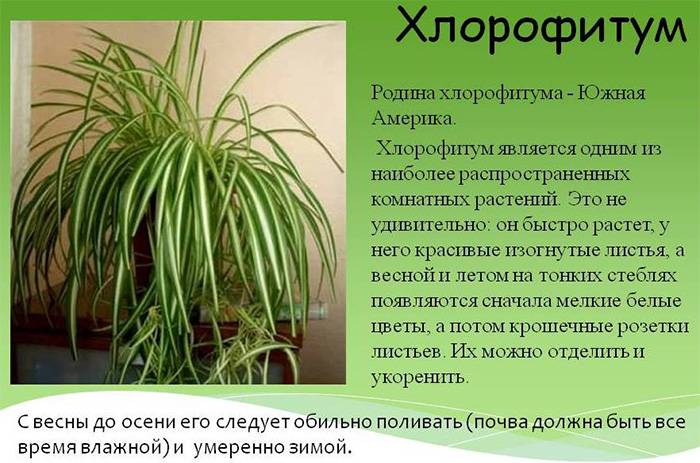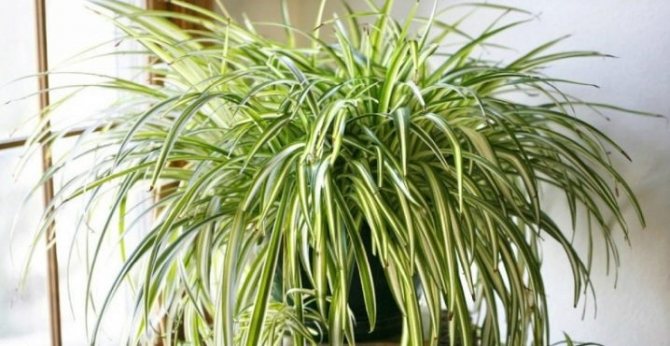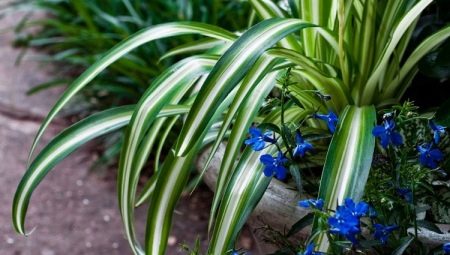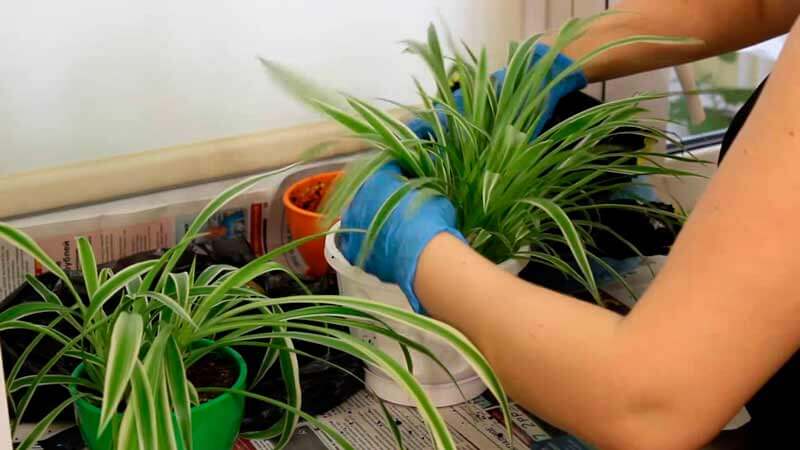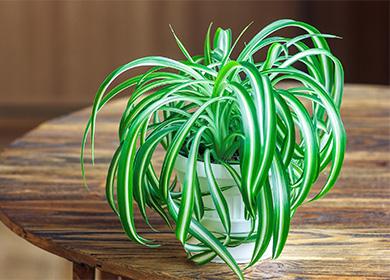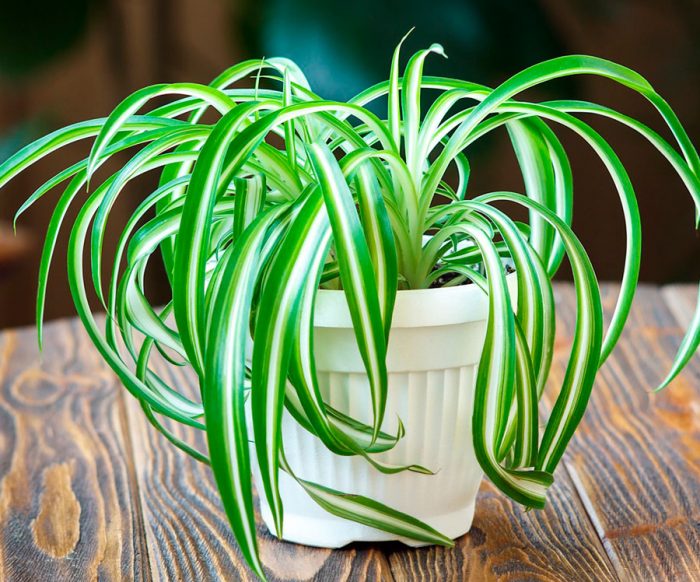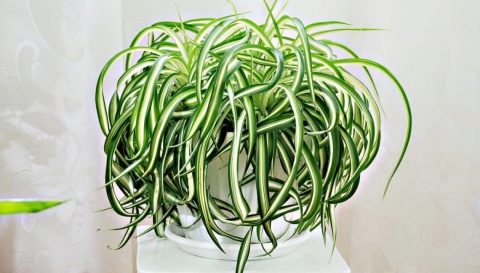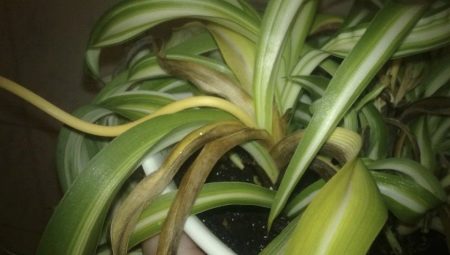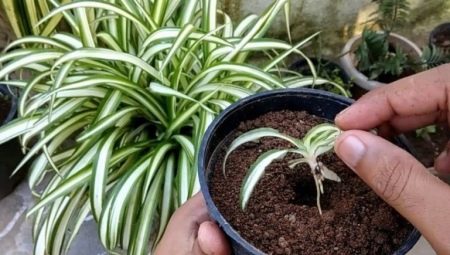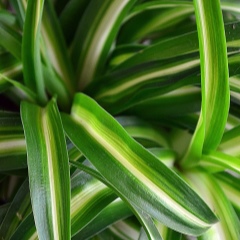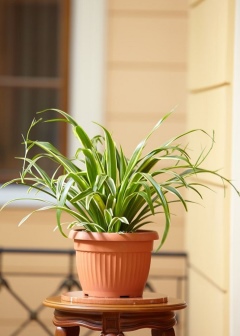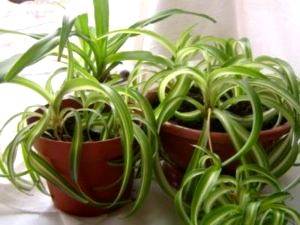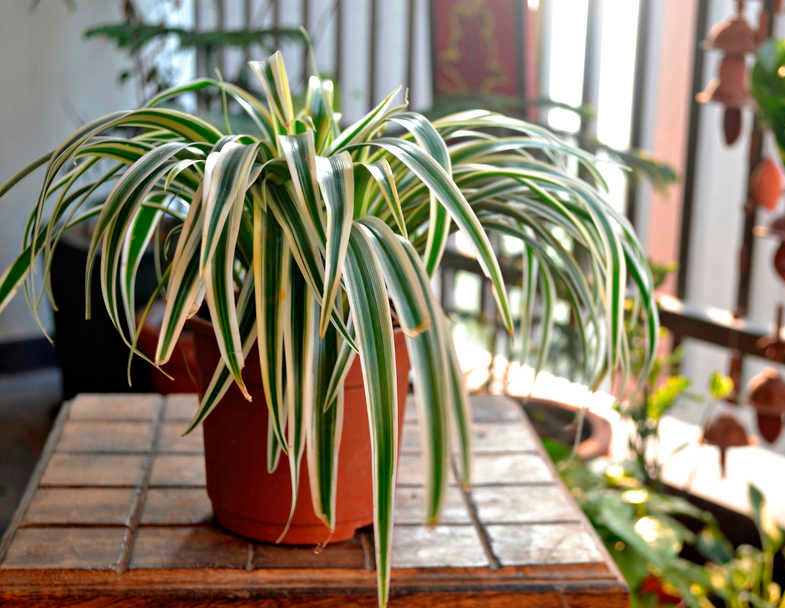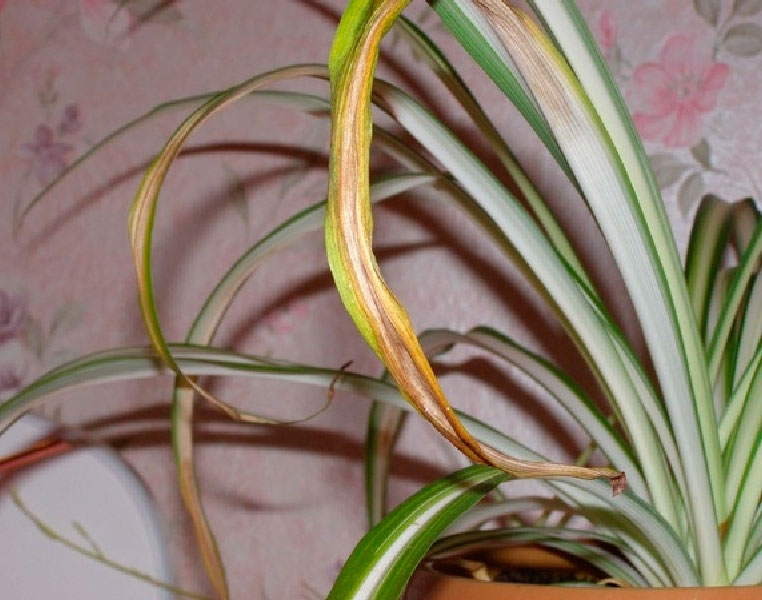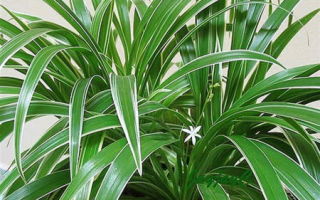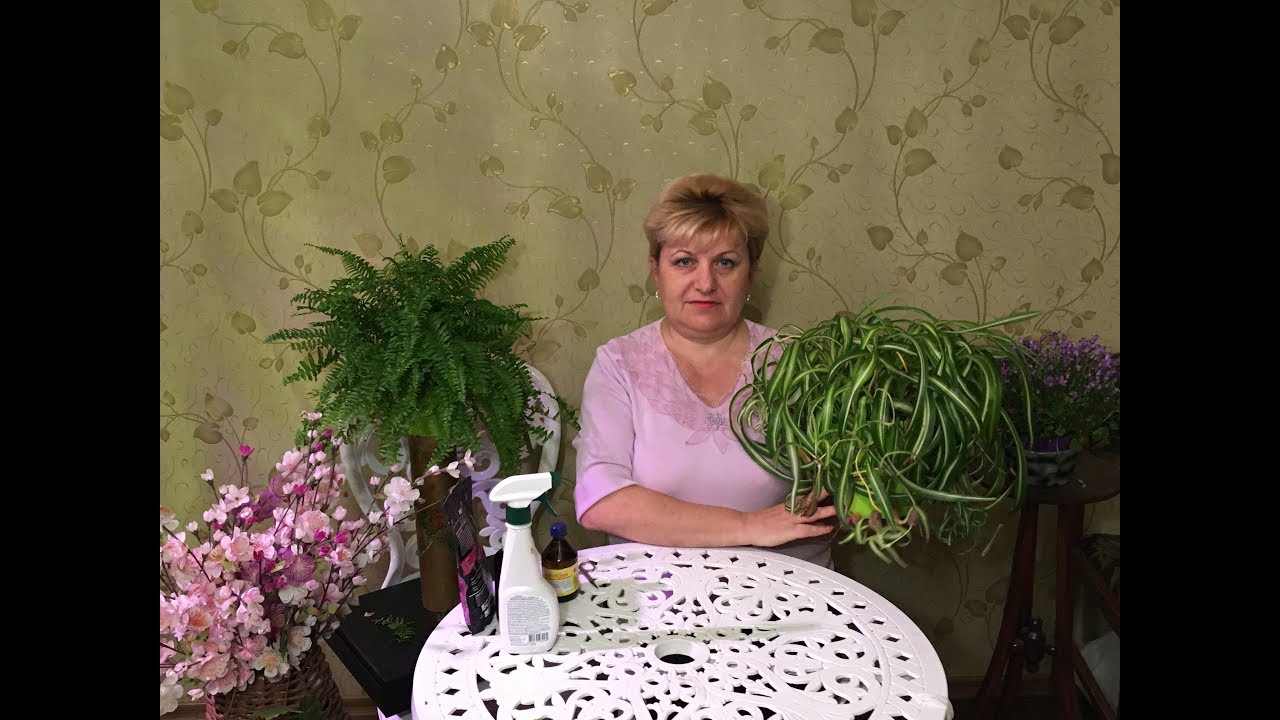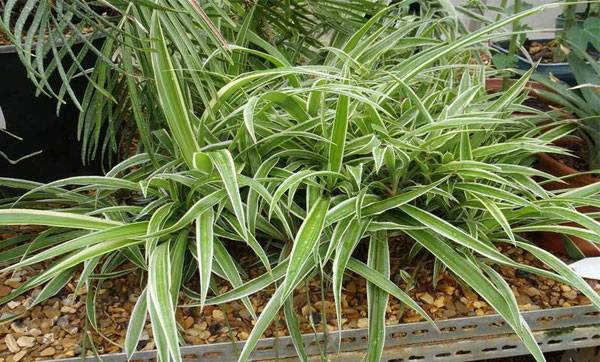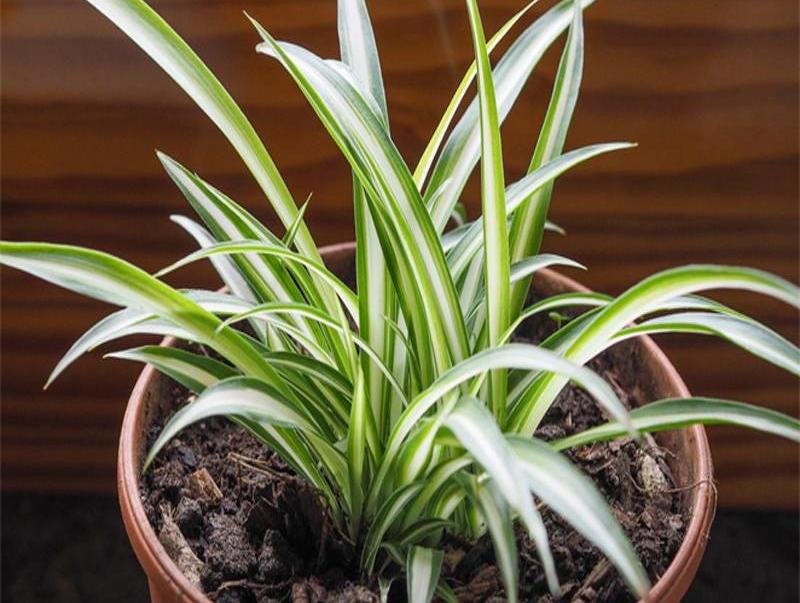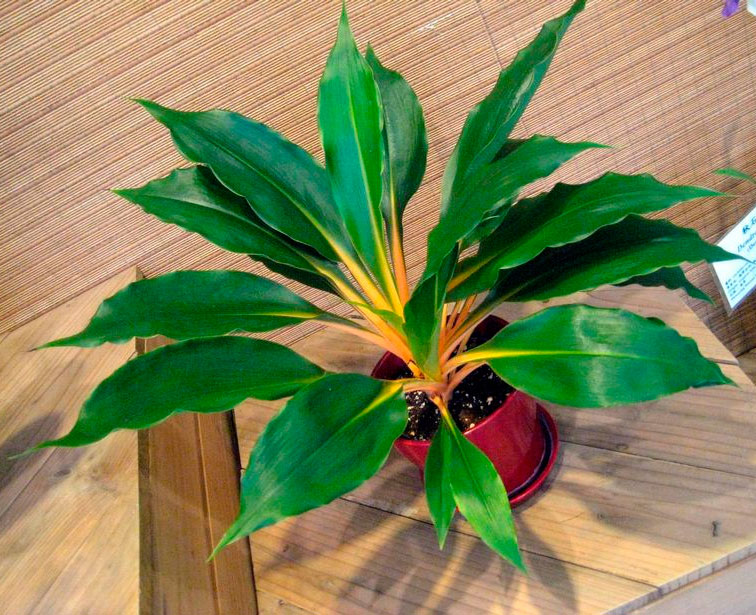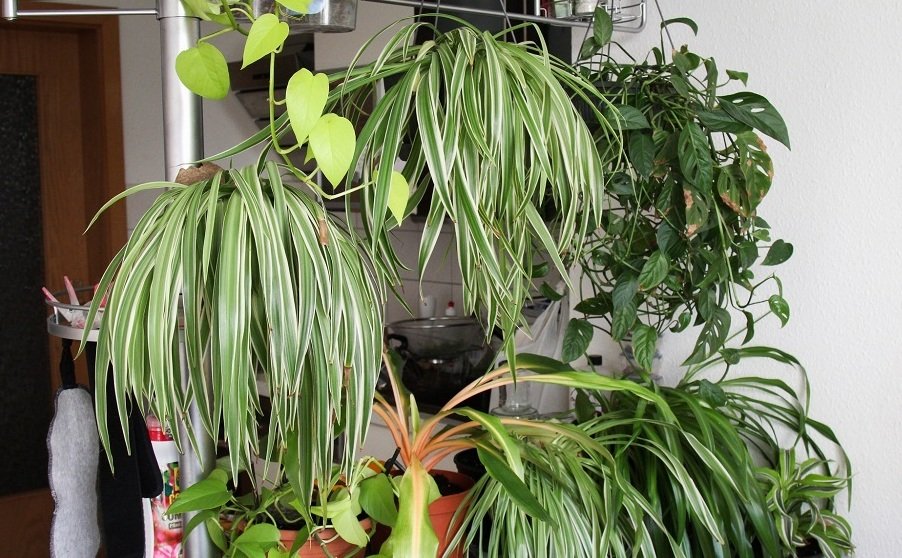Chlorophytum: home care
Non-capricious chlorophytum can be grown even by a novice amateur florist. However, this does not mean that the flower does not need supervision at all. You need to take care of the flower, if you follow a few rules, chlorophytum will not cause problems.

Only proper care will relieve the flower of diseases.
Temperature
The plant requires a room temperature of 15 ° C to 25 ° C to grow. It dies at temperatures below 10 ° C. Chlorophytum does not tolerate cold drafts, therefore it is necessary to protect it from unfavorable climatic conditions.
Lighting
Chlorophytum grows well even with minimal room illumination. The main thing is not to completely deprive the flower of sunlight, otherwise, like any plant, its growth will be delayed, and the leaves will be small. The reason is a violation of photosynthesis in plant tissues, which does not function without light.
Note! The flower cannot stand strong light, so it must be grown on windowsills from the eastern or northern part of the house. Dry edges of sheet plates are the first sign of excessive room illumination
Watering
A tropical plant loves moisture, so when leaving it, you need to water it regularly. In hot summer periods, watering is necessary abundantly, and in the cool winter months, the procedure is carried out only when the top layer of the soil in the pot dries up.
After watering, the soil must be loosened to avoid stagnant moisture. Only this is done very carefully, otherwise there is a high probability of damage to the root system.
Important! Watering should not be carried out with hard cold running water. The water should settle for a while and warm up to room temperature.
If possible, it is better to use rain or river water for irrigation.
Spraying
Needs spraying of the ground part of the bush. This is done using a spray bottle with water. You need to spray the plant carefully, but not with strong pressure, otherwise the leaves and flowers will be damaged
Particular attention should be paid to a small hollow in the middle of the sheet plate, where the largest amount of dust accumulates.
Spraying helps to get rid of dirt and dust that has accumulated on the leaves, and additionally increases the humidity of the air.
Humidity
The flower needs high humidity in the room. In winter, heating causes the air in the room to become dry, so it is necessary to increase the humidity. To do this, regularly spray the flower with water, hang a damp rag on the heating pipe, or put a container of water next to the pot.
What pot and soil is needed for chlorophytum
Chlorophytum has very thick and long roots, so a spacious container is needed to grow it. In the first years of growth, transplanting and changing the pot is required.

If the plant grows, it is necessary to change the pot.
The substrate for planting should consist of a mixture of rotted leaves, turf, sand and humus earth. During cultivation, the soil in the pot should always be loose and moist.
Top dressing
For healthy growth, top dressing is mandatory. In the spring, at the beginning of active growth, they begin to feed the flower with organic and mineral fertilizers. It is best to use a special complex for ornamental deciduous plants. They already contain the required amount of minerals and nutrients.
Pet Transplant
After purchasing chlorophytum, it must be transplanted into another pot, no matter what time of year.To transplant a plant, you need to take voluminous pots, since chlorophytum has very fast growth, its root system develops very powerful. If you choose a small container, then after a while it will simply crack.
- Chlorophytum transplant is best done in spring. Transplantation of adult and young flowers is most often carried out in late February or early March.
- It is recommended to purchase the soil in a specialized store, but you can make it yourself. To prepare the soil yourself, you need to take sand, leafy and turf soil. Chlorophytum grows well in slightly acidic soil.
- In the case when the soil for a home flower was taken from the garden, it is necessary to disinfect it, since it can contain dangerous bacteria, larvae and any pests. To clean the ground, you can spill it with a solution of potassium permanganate, hold it in the oven or in the refrigerator.
- At the beginning of the transplant, expanded clay is poured into the pot. It should take up about half the volume of the entire pot. Next, the soil is filled up.
- To remove the chlorophytum, you need to lightly tap the pot. After that, the plant is gently taken by the trunk closer to the roots and pulled out of the pot.
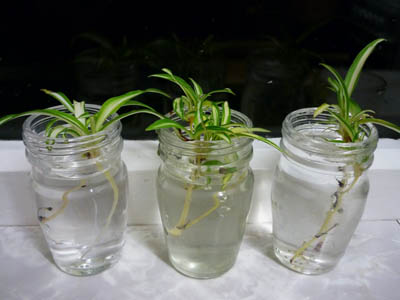
Now the plant is immersed in a new pot. Chlorophytum should be positioned so that the roots are 2-3 cm lower than the level of the pot. Next, the rest of the soil is filled up. To distribute the soil well, you need to shake the pot slightly. At the end, drainage is poured onto the ground
When the transplant is over, it is important to water and spray chlorophytum
Chlorophytum should be transplanted once a year when the flower is still young, and twice a year if it is mature. A sure sign that it is time to transplant chlorophytum are the roots that can be seen from the ground and the plant stops growing.
If chlorophytum is properly cared for, it will be able to maintain a healthy appearance for many years to come.
How to care for chlorophytum at home?
Chlorophytums, famous for their unpretentiousness and endurance, can be safely recommended to beginner flower growers and those who, due to forgetfulness or busyness, often forget about their green wards.
Left without watering, in the heat or cold, the plants lose the brightness of their foliage, stop growing, but survive thanks to the peculiar reserves of nutrients on the thickened roots. It is worth transferring chlorophytum to comfortable conditions, most of the leaves regain their former, fresh look. And that's all, you should not tempt fate!
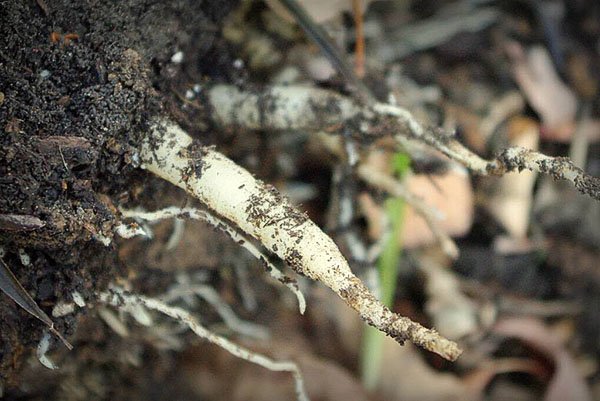
What conditions do indoor flowers need? How to organize home care for orange and crested chlorophytum?
The place for the pot with chlorophytum is chosen so that the plant is exposed to diffused light for at least 12 hours a day. For variegated forms, the lighting should be somewhat brighter than for their completely green counterparts. If the flower feels sun deficiency:
- the variegated plant will gradually turn green, losing its bright striped color;
- green species will fade, and a long stay in the shade leads to yellowing of the leaves.
Therefore, organizing the care of chlorophytum at home, as in the photo, it is given a place on the east or west windows. Placing it on the south side, it is better to move the pot deeper into the room. In the summer, it is useful to take the flowers out into the fresh air, and in the winter it is possible and necessary to illuminate
But here it is also important not to overdo it. With an excess of sunlight and direct exposure of plants to direct rays, first light, and then dried, brown traces of burns appear on the leaves. Regular care of chlorophytum at home is reduced to watering, moderate feeding and transplanting, when the powerful roots of the plant completely occupy the entire volume allotted to them. pot
For a comfortable life, a culture needs a temperature of 18–25 ° C. If the pot is kept cool during the cold season, the plant can be kept at 10-12 ° C, but only in dry soil.Watering at such a time is fraught with rotting of the root system and death. In a warmer room, the flower is watered regularly, but waiting for most of the earthen coma to dry out. With the onset of spring and in summer, especially in the heat, watering is increased.
- From spring to late autumn, while the flower forms daughter rosettes and blooms, it is fed with complex products for indoor plants with decorative foliage.
- The frequency of fertilization varies from 1 to 2 times a month, depending on the state of the flower.
- Overfeeding the plants is not worth it, as this threatens to weaken your own immunity and reduce resistance to pest attacks.

Unlike other indoor crops, chlorophytum does not need spraying or other measures to increase air humidity. And yet, you can hear the question from flower growers: "What to do if the tips of the leaves of chlorophytum dry?" Indeed, this symptom may indicate excessive dryness of the air. But more often it signals a lack of watering. If you moisten the soil in time and put into practice the warm shower so beloved by the plant, the new leaves will be juicy and bright from the base to the tips.
Types of chlorophytum: what are and how they look
If our information has already made you think about breeding this unpretentious flower in your home, be sure to look at the main varieties of this plant. In addition to the usual configurations of leaves, quite interesting specimens can be found.
At the same time, it does not matter which type you prefer - all chlorophytums have useful properties and perfectly clean the air in the room. More on this later in our article.
Main varieties:
- Chlorophytum crested. Leaves often have a snow-white border around the edges. Their shape is rather curving, we can say that they are curly. This explains the second name of the flower. Curly chlorophytum is often used in group plantings, because this bush looks quite appropriate for landscaping housing and landscape design. This species is usually sold commercially under the name Bonny Chlorophytum, so you can search for it that way.
- Chlorophytum orange. This spectacular plant is not difficult to recognize. Although it does not fit the usual image, it is one of the types. The leaves are very wide, but the main notable detail is the change in color at the points of attachment to the stem. The color in this area ranges from pale yellow to reddish orange. It is thanks to this color that this variety is becoming more and more popular.
- Chlorophytum Laxum is distinguished by dark green glossy leaves with a distinct white border around the edges. It looks unusually impressive, besides, the width of the leaves is greater than that of curly chlorophytum, which makes it original and unusual. Retains useful properties and unpretentiousness, but is more demanding on lighting.
- Chlorophytum Cape. This view will surely be remembered by everyone. Narrow leaves of a solid green color, as well as good growth and the ability to release shoots - children. This is the same "normal" chlorophytum that can withstand both bay and drought.
Regardless of the type, all flowers are distinguished by excellent qualities and are very unpretentious in care. You can easily choose the best option, besides, even buying in a specialized store will not hit your pocket - chlorophytum is quite popular and an inexpensive indoor flower.
Reproduction
Chlorophytum reproduces either through rosettes (lateral appendages on the plant) or by dividing the bush during transplantation. The rosettes of this flower take root easily.
After chlorophytum has been planted, it begins to grow rapidly and give side shoots, which are whiskers with small white flowers.
Further, at the ends of such plant shoots, rosettes appear, which form their own roots.
Plants that reproduce by dividing the bush can take root without any problems.
With this reproduction option, the chlorophytum bushes will immediately be larger than in the case of rosette propagation.
The division of the plant takes place in the process of its transplantation.
At the same time, it is important to examine its roots and remove dry and rotten ones.

The plant also propagates by seeds, however, during the cultivation of chlorophytum at home, the use of this method is considered inappropriate.
What does chlorophytum look like?
The herbaceous plant chlorophytum is a flower that traditionally belongs to the Liliaceae family, but some botanical catalogs include it in the Asparagales family. Long linear leaves are collected in powerful basal bundles. Small flowers blooming on very long (up to 1.5 m and more) peduncles form a loose brush. On the same peduncles, after the flowers have faded, babies are formed - bunches of leaves with air roots.
 What does chlorophytum look like with babies
What does chlorophytum look like with babies
For your information! The color of the leaves depends on the variety and can be uniform green or variegated with contrasting stripes.
Chlorophytum is prized as a plant that absorbs large quantities of carbon dioxide. It absorbs carbon monoxide, acetone, nicotine and formaldehyde from the air. In the kitchen, as well as in smoking rooms, he is perhaps the only one capable of not only surviving, but also improving the atmosphere.
For the first time, the mention of an inhabitant of the South African subtropics in historical chronicles was discovered in 1794. Some of the species are native to South America. Today, on all continents, the flower is grown in homes and offices, appreciating for its unpretentiousness and ability to heal the atmosphere. The name translated from Latin means "green plant", which exactly corresponds to its appearance.
Post-seedling care
After transplanting, indoor plants require additional care. The temperature regime in the room should not be too low (at least 10 degrees), but at the same time should not exceed 20 degrees. The flower loves natural light, so you don't need to place the plant in dark corners of the room.
As for watering, chlorophytum does not like moisture too much. Watering should be done in moderation, focusing on the dryness of the soil. In the summer season - about every other day, in winter - based on the temperature and humidity in the room. Provided that the temperature remains the same as in summer, exactly the same. However, if the temperature drops, then the number of waterings is reduced to 2 per week. In addition, you must not forget to monitor the condition of the soil.
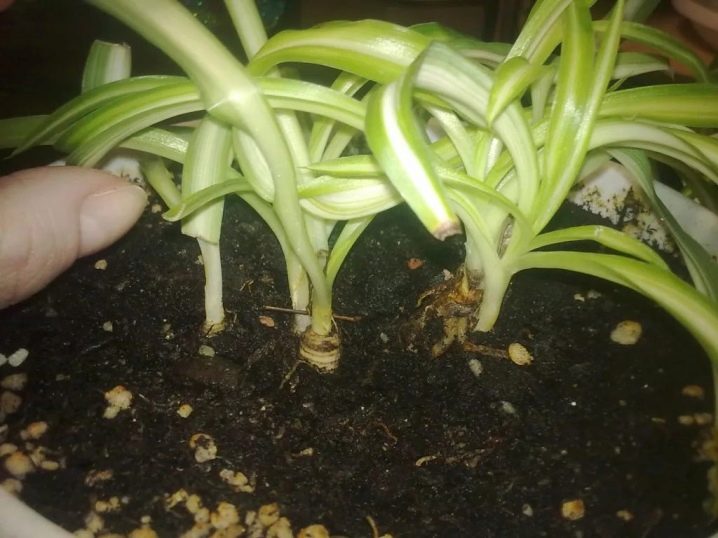
You do not need to touch the leaves of chlorophytum, as they are quite sensitive. In order to get rid of the dust accumulated on the leaves, it will be enough to spray the plant at least once a month. Often this is not necessary either. Many people have a question about cutting off the whiskers, which appear in adult representatives of chlorophytum. This should be done if you want the flower to have more leaves. In this case, they can be carefully trimmed.
If in the future you want to use seeds for planting chlorophytum, you do not need to touch them. The only condition is that you need to watch out for dry leaves, which must be removed periodically. Fertilization is necessary for the plant during the growing season (spring-autumn). If you feed the flower once a month with various stimulants and minerals, very soon you will be able to plant the plant in one of the above ways.
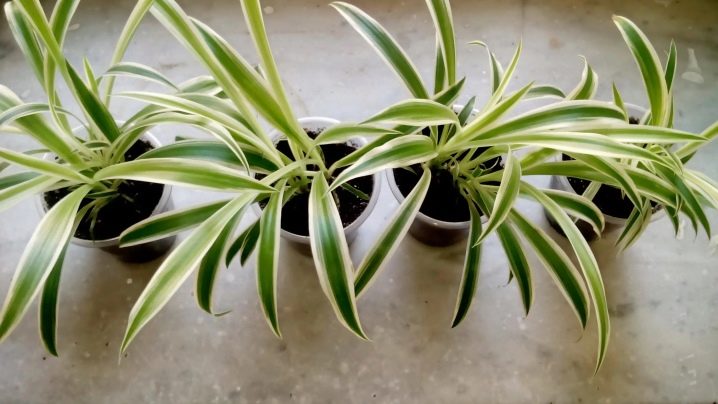
Chlorophytum properties
The chlorophytum plant in your apartment is not only an interior decoration, but also a real filter for air purification - that is why most often housewives keep it in the kitchen, where various harmful impurities from the heat treatment of food, smoking and hygiene chemicals are in the air. And one adult chlorophytum is able to neutralize these miasms by 70-80%.On an area of two meters, one chlorophytum is able to destroy all pathogenic microflora, while humidifying the air for your comfort, if, of course, you do not forget to water it.
To enhance moisture exchange, put a couple of activated charcoal tablets in a pot with a plant, directly on the ground. In addition, sometimes you can shower chlorophytum to remove dirt and dust from its leaves, and then it will be ready to cope with its duties of cleaning and humidifying the air in your home again. There is such a nice prejudice: if you bring chlorophytum to a new house or apartment, then very soon it will become cozy and calm in your home, because where chlorophytum is, there is no place for irritation and bad memories.
And experts in feng shui claim that chlorophytum is able to cleanse the aura and bring harmony into the life of a busy person, to even out imbalances in the owner's personal life. Should I believe? Do not know. But from the fact that the air in your room will become cleaner, you definitely won't get any worse, right?
Features of caring for curly chlorophytum at home
Many gardeners confirm that caring for chlorophyte is a pleasure. In order for a flower to grow well, develop and give lush flowering, you should not neglect agricultural technology.
Temperature
Since chlorophytum is native to South Africa, the plant does not tolerate low temperatures and the presence of drafts. The temperature should not fall below +18 ℃. In winter, it is better to place a flower pot in a heated room on a warm windowsill.

Reproduction of chlorophytum at home
Lighting
The flower loves diffused light and needs it. If the pot is placed in the shade, nothing will happen to the chlorophytum. The plant is often placed in hallways, stairwells and corridors.
Watering
The tropical origin determines the need for frequent and abundant watering at high room temperatures. The soil in the pot should not dry out, but always be kept moist.
Note! In the autumn-winter period, watering is carried out in moderation.
Spraying
Chlorophytum bonnie of the curly variety loves high humidity. From time to time they give the flower a light shower. This is especially true of such a situation when the pot is close to the radiators.
Humidity
The flower tolerates dry air in the house normally, with the exception of the summer season. During this period, it is imperative that the crown is sprayed daily with settled water.
Priming
The soil for planting a flower should be loose, well-permeable, but nutritious. A mixture of soil from under coniferous (deciduous) trees, coarse sand and humus is suitable. Do not forget about the drainage layer, which will retain moisture for a long time.
Top dressing
Bonnie loves chlorophytum fertilizing. Fertilizing is necessary only in the summer. Ready-made compositions for indoor deciduous plants are suitable. Frequency - once every 2 weeks.
Possible growing problems
This is noticeable by the following features:
- the tips of the leaves turn black or brown due to excessive watering;
- leaves turn yellow and become dull due to insufficient pot volume or due to poor lighting;
- slow growth is associated with heavy soil or a large area of the pot, when all the forces of the plant go to the development of the root system;
- the absence of "children" is associated with a lack of light or a tight container;
- curling leaves depends on a lack of nutrients;
- lack of flowering is a sign of an excess of nutrients;
- yellowing of leaf tips is associated with a dry microclimate;
- leaf fragility is possible with an excess of nutrients in combination with poor lighting.
Danger of pests
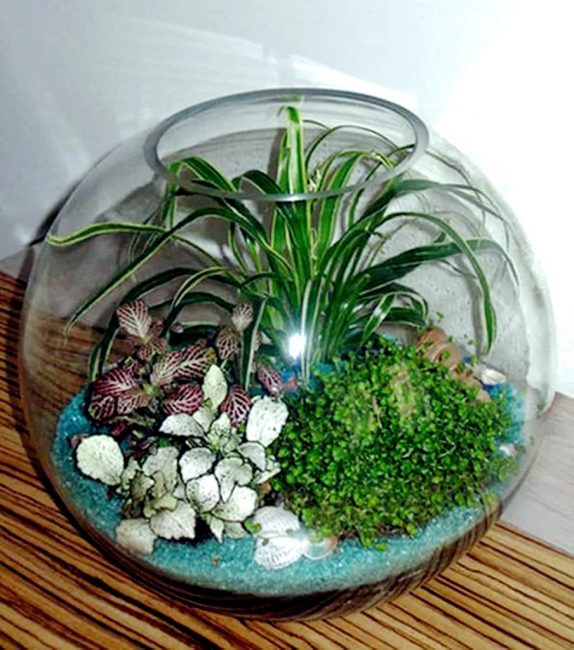
Home florarium with chlorophytum, which forms the basis of the composition
Among other problems, pests may attack:
An ornamental deciduous plant does not bypass aphids. It draws sap from different parts, causing the formation of yellow spots on the surface of home chlorophytum.It is easy to deal with it using soapy water. A sponge is moistened in it and leaves are wiped. Infusions and decoctions of tobacco, bitter pepper, garlic help
It is more difficult to deal with spider mites. It also feeds on plant sap, which makes the leaves of the "green lily" sluggish and drooping
Acaricide preparations are used against the tick, taking precautions
The mealybug (hairy louse) also likes the delicate leaves. Sucking insects retard plant growth
It is not difficult to treat a deciduous plant with soapy water, removing insects with a soapy sponge. Then spray 3 times with green soap. Tobacco infusion, garlic infusion, cyclamen broth, calendula alcohol tincture will help
The petioles and stems are affected by the scabbard. Small "parasites" stick to the leaves. In these places, yellow spots appear, which increase in volume. Chlorophytum gradually stops growing and dies. The scale insects form a sticky composition - a honeydew or sooty fungus, which disrupts the process of photosynthesis. They are difficult to destroy, since there is a shield on the surface of the pest's body. First, the insect is washed off with soapy water, and then the leaves are treated with an insecticide
Another enemy is thrips. It is difficult to notice them immediately due to their small size. They feed on the sap of the plant, infecting it with secretions. At the site of the bites, tissue necrosis occurs, then a hole, and ultimately, wilting and leaf fall occurs. Fitosporin, Fitoverm, Aktara helps in the fight

Thrips
If pests are detected in time, then it is enough to use folk remedies to get rid of them. If the situation is out of control, then you cannot do without "heavy artillery" in the form of chemicals.
"The lethargy and dullness of chlorophytum can be associated with the poor energy of space," - the ancient teaching of Feng Shui interprets. The unsightly appearance of the plant indicates the accumulated negative energy. The problem of people and flowers will be solved by creating an atmosphere of joy and celebration.
Despite its unpretentiousness and endurance, the "green lily", like any houseplant, needs proper care. Growing chlorophytum is not a tricky business. With careful attention, it looks great and works as a "green filter", purifying the air of our apartments, creating coziness and delighting with a fountain of lush, fancy foliage.
9
Total Score
Chlorophytum home
9 Average rating
Ease of care
9
Appearance
8.5
Bloom
8.5
Originality
10
8.9 User rating
Ease of care
9.8
Appearance
9
Bloom
8.4
Originality
8.4
|
External features of the plant
Chlorophytum has a short stem. The length of its leaves can be different, depending on the variety. They are the longest (up to 60 cm or more) in ampelous varieties. Narrow, with pointed ends, the leaves are linear-lanceolate, much less often oval. They are collected in lush rosettes or bunches.
Approximately the same - by 50 cm - the bush grows in height and width. Cases have been recorded when an adult healthy plant grows up to a meter in height and in diameter, its leaves create magnificent cascades up to one and a half meters in length. On average, a perennial lives for about 10 years.
Long shoots with aerial roots and small leaves grow from the center of the bush. In summer and spring, chlorophytum produces curved long peduncles. At their ends, small silvery-white flowers appear in the form of stars, a bit like tiny lilies. They look very original against the background of long green or variegated leaves.

When the flowers wither, fruit-boxes appear, as well as small rosettes with leaves and aerial roots. These are the children of chlorophytum. The flower has tuberous, thickened roots, colored brown or yellow. They can accumulate such an amount of moisture that the plant can live without watering and spraying for up to a month.In this case, your pet will lose its decorative appearance: beautiful long leaves will fade and sag around the edges of the pot. However, the plant will not die, but will patiently wait for the owner to remember it. As soon as watering chlorophytum resumes, it will revive and very soon restore its attractiveness.

